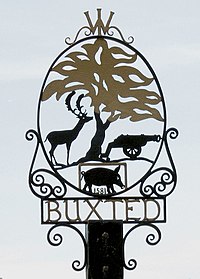Buxted
| Buxted | |
|---|---|
 Buxted village sign |
|
| Buxted shown within East Sussex | |
| Area | 21.6 km2 (8.3 sq mi) |
| Population | 3,343 (2011) |
| • Density | 376/sq mi (145/km2) |
| OS grid reference | TQ499234 |
| • London | 37 miles (60 km) NNW |
| Civil parish |
|
| District | |
| Shire county | |
| Region | |
| Country | England |
| Sovereign state | United Kingdom |
| Post town | UCKFIELD |
| Postcode district | TN22 |
| Dialling code | 01825 |
| Police | Sussex |
| Fire | East Sussex |
| Ambulance | South East Coast |
| EU Parliament | South East England |
| UK Parliament | |
| Website | Buxted Parish |
Buxted is a village and civil parish in the Wealden District of East Sussex in England. The parish is situated on the Weald, north of Uckfield; the settlements of Five Ash Down, Heron's Ghyll, Hadlow Down and High Hurstwood are included within its boundaries. At one time its importance lay in the Wealden iron industry, and later it became commercially important in the poultry and egg industry.
The village has both road (the high street is also the A272) and rail links to Uckfield and to London via Oxted.
The origin of the name Buxted comes from the Saxon Bochs stede (place of the beeches).
The iron-making industry became a major part of Buxted's early prosperity. The first standard blast furnace was called Queenstock and was built in Buxted parish in about 1491. The cannon-making industry in the Weald started at a furnace on the stream at Hoggets Farm lying to the north between Buxted and Hadlow Down. The first cast iron cannon made in England was cast in 1543 by Ralf Hogge, an employee of Parson William Levett, a Sussex rector with broad interests, paradoxically enough, in the emerging English armaments industry.
Levett was removed as Buxted's vicar in 1545 by Thomas Cranmer, Archbishop of Canterbury. But thanks to friends in high places, Levett was quickly reinstated. After regaining his clerical position, Levett died a very wealthy man, thanks to his iron mining and smelting operations, founded by his brother John Levett, one of the founders of the Sussex iron industry and one of the wealthiest men in Sussex, who controlled 20 Sussex manors at his death in 1535. The family is of Norman descent and one of the oldest in Sussex. William and John Levett were the sons of a large landowner in the Hollington area of Hastings, Sussex. In his lengthy will, parson William Levett left large charitable bequests which he directed be supervised by his friend Anthony Browne, 1st Viscount Montagu. Richard Woodman, an ironmaster was born here, but he was burnt as a Protestant martyr in 1557.
...
Wikipedia

